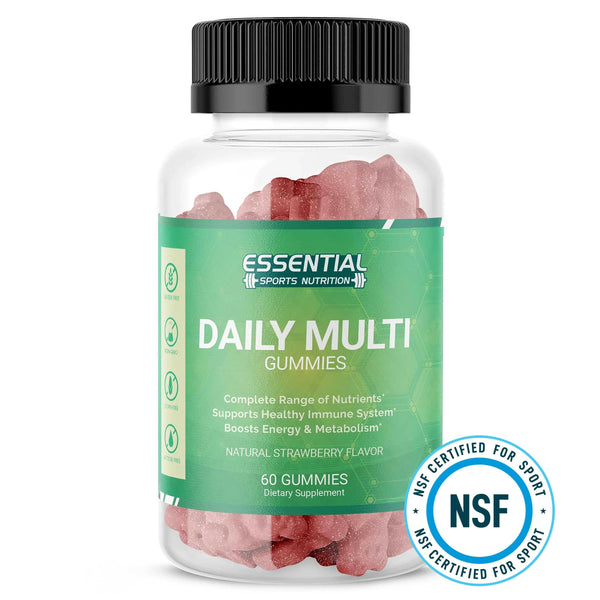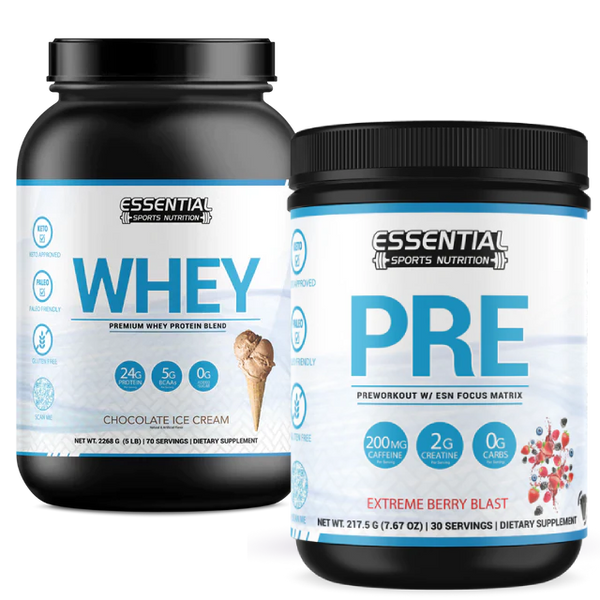Sumo Deadlift: Proper Form, Benefits, and Variations for Less Back Strain
Sumo deadlifts are great for both expert lifters and beginners. In this article, we'll cover how to do sumo deadlifts correctly, their benefits, and different ways to do them. You will know everything you need to to add this exercise to your workout safely and effectively.

Key Takeaways:
- Sumo deadlift is a variation of the traditional deadlift exercise.
- It targets multiple muscle groups, including the glutes, adductors, hamstrings, quadriceps, back, core, and calves.
- Proper form is essential to perform the sumo deadlift effectively and prevent injury.
- There are various variations of the sumo deadlift to add variety and challenge to your workouts.
- Both beginners and experienced lifters can benefit from incorporating the sumo deadlift into their training routine.
How to Perform the Sumo Deadlift with Proper Form
To do the sumo deadlift the right way, follow these steps:
- Start by standing in front of the loaded barbell in a wide stance with your toes pointed slightly outward.
- Position your arms inside your knees and place your hands on the bar inside your feet.
- Keep your shins perpendicular to the floor and ensure your shoulders are above the bar.
- Maintain a flat back throughout the movement, engaging your core.
- Brace your lower back, legs, and glutes, and pull up on the bar while pressing your legs into the floor.
- Lift the bar along your legs, focusing on the upward movement.
- Squeeze your glutes at the top position, fully locking out your hips.
Keep your form right throughout the sumo deadlift. This means having a flat back, using your core, and pushing your legs down. By following these steps, you'll do the sumo deadlift correctly. This targets the muscles you want to work.
Pro tip: Try different foot placements and grip widths. Find the sumo deadlift style that works best for you.
Muscles Worked by the Sumo Deadlift
The sumo deadlift is great for hitting multiple muscle groups. It builds functional strength. Use the right technique to work these muscles:
Glutes
The glutes get the most focus in the sumo deadlift. Working these muscles gives you stability and strength for movement.
Adductors
This exercise targets the inner thigh muscles too. They help keep the hips stable.
Hamstrings
The hamstrings are key for this lift. They help with moving the hips and bending the knees. This strengthens the back of your thighs.
Quadriceps
The quadriceps on the front of your thighs also work hard. They help with knee movement and keeping stable during the lift.
Back
Your back muscles, like the erector spinae, latissimus dorsi, and trapezius, are activated too. They keep you upright, stabilize your spine, and add to your strength.
Core
The core muscles are crucial for keeping your spine in line. A strong core helps you keep good form and avoid injuries.
Calves
Last, the sumo deadlift works your calves. These muscles help stabilize you and assist with movement during the lift.
By using the correct form and doing sumo deadlifts, you can strengthen these muscle groups. This leads to better overall strength and performance.
| Muscle Group | Example Muscles |
|---|---|
| Glutes | Gluteus maximus, medius, minimus |
| Adductors | Inner thigh muscles |
| Hamstrings | Biceps femoris, semitendinosus, semimembranosus |
| Quadriceps | Vastus lateralis, vastus intermedius, vastus medialis, rectus femoris |
| Back | Erector spinae, latissimus dorsi, trapezius |
| Core | Rectus abdominis, obliques, transverse abdominis |
| Calves | Gastrocnemius, soleus |
Benefits of the Sumo Deadlift
The sumo deadlift is great for weightlifters. It puts less strain on the lower back because you stand upright and it starts closer to the ground. This is perfect for those with back tightness or who want to protect their back.
Sumo deadlifts also boost your strength when pulling. They improve your lockout strength and work specific muscles like your glutes and quadriceps.
Want a strong, balanced body? Adding sumo deadlifts to your workouts offers benefits like:
- Reduced strain on the lower back
- Increased leg and hip strength
- Improved explosive power
- Enhanced muscular development in the glutes, quadriceps, and hamstrings
- Better overall body mechanics and posture
Reduced lower back strain
The sumo deadlift lessens lower back strain. Its stance and upright position during the lift lessen the pressure on your back muscles. It’s great for anyone who feels discomfort in their lower back with traditional deadlifts.
Increased leg and hip strength
This deadlift focuses more on the legs and hips than the normal one. The wide stance and foot placement work the quadriceps and glutes more. This increases strength in your legs and hips. It helps with sports and daily movements.
Improved explosive power
The sumo deadlift needs a powerful start to lift the weight. This helps build fast strength, which is useful in sports that need quick moves, like running, jumping, and throwing.
Enhanced muscular development
It targets the glutes, quadriceps, and hamstrings, building strength and developing these muscles. The stance, squat position, and focus on extending the hips engage these muscles more. This leads to better muscle definition.
The sumo deadlift is excellent for lifters at any level. Whether you're new and looking to get stronger legs or a pro wanting new challenges, sumo deadlifts have many benefits for you.
Variations of the Sumo Deadlift
The sumo deadlift is a versatile exercise. It can be tailored through variations to add volume and variety to workouts. These changes can target specific muscles, boost strength, and make workouts fun.
Deficit Sumo Deadlifts
Deficit sumo deadlifts target pulling strength from the floor. They are done by standing on a platform or weight plate. This lowers the starting point and increases the bar's travel distance, making the lift harder and working muscles differently.
Sumo Deadlifts with Bands or Chains
Adding resistance bands or chains to sumo deadlifts creates a unique challenge. This method, known as sumo deadlifts with accommodating resistance, changes the lift's strength curve. At the lift's peak, the bands or chains add extra resistance. This makes the top part of the lift harder, improving lockout strength and addressing weaknesses.
Sumo Deadlift High Pulls
The sumo deadlift high pull is a dynamic variation that combines the sumo deadlift with an explosive movement, targeting the hips and upper back.
Sumo deadlift high pulls add an explosive move to the usual sumo deadlift. This engages the hips and upper back more. It's great for boosting power and explosiveness, which are vital in sports and Olympic weightlifting.
| Sumo Deadlift Variation | Focus | Benefits |
|---|---|---|
| Deficit Sumo Deadlift | Increased Range of Motion | Enhanced pulling strength from the floor, increased demand on targeted muscles |
| Sumo Deadlift with Bands or Chains | Lockout Strength | Improved lockout position, increased resistance at the top of the lift |
| Sumo Deadlift High Pull | Explosiveness | Enhanced power and explosiveness, improved performance in explosive movements |
Adding these sumo deadlift variations to your routine can challenge your muscles in new ways. They help target weak areas and keep you moving towards your fitness goals.
Sumo Deadlift vs. Conventional Deadlift
Both the sumo deadlift and conventional deadlift are great for building muscle and strength. Yet, they have key differences. These differences matter when picking one for your routine.
Sumo Deadlift
The sumo deadlift has a wide stance, beyond shoulder width. This stance means a straighter spine and more work for your thighs, glutes, and inner thighs. It’s good for those with longer limbs, as it eases the load on the hamstrings and lower back.
The sumo deadlift's wider stance can be advantageous for individuals with mobility limitations, as it reduces stress on the lower back while still targeting key muscle groups.
Conventional Deadlift
The conventional deadlift uses a closer stance, around hip-width. This focuses more on the hamstrings and lower back. It's perfect for strengthening these areas. Plus, this stance encourages a longer range of motion, effectively working the back of your body.
The conventional deadlift is a staple exercise for developing overall strength and power. It targets the posterior chain, which includes the hamstrings, glutes, and lower back.
Choosing the Right Variation
Choosing between sumo and conventional deadlifts depends on your goals and body shape. Sumo may suit those with longer limbs for a comfier stance. But, if your focus is on the hamstrings and lower back, go for the conventional deadlift.
Including both deadlift styles in your routine is wise for many lifters. It ensures full muscle development and helps avoid injury. This way, you work on different muscle groups evenly.
| Sumo Deadlift | Conventional Deadlift |
|---|---|
| Wider stance | Narrower stance |
| Emphasizes quadriceps, glutes, and adductors | Emphasizes hamstrings and lower back |
| Reduced range of motion for hamstrings and lower back | Greater range of motion throughout the posterior chain |
Tips for Incorporating the Sumo Deadlift into Your Workout Routine
If you're new to the sumo deadlift, starting right is key. Begin with proper technique and up your weight slowly. Get comfortable step by step.
1. Begin with lighter weights
Starting light is crucial for beginners. It’s all about mastering the sumo deadlift form and technique. This builds a strong foundation and avoids injury.
2. Stance width
The stance in a sumo deadlift is crucial. Your arms go inside your knees with hands on the bar, inside your feet. This stance drives your leg power and targets muscles well.
3. Maintain a flat back
Keeping a flat back throughout is vital. It lowers injury risk and targets muscles rightly. Always keep your spine neutral and core engaged.
4. Keep your shins perpendicular to the floor
For the sumo deadlift, shins must stay perpendicular to the floor. It boosts leg drive and works lower body muscles best.
5. Engage your core
Engaging your core is key for this lift. It brings stability and power. Brace your core and keep tension to protect your back and boost performance.
6. Seek professional guidance
Unsure about your technique? A fitness pro or trainer can help. They offer feedback and tips to improve your form and technique.
Follow these tips to make the sumo deadlift a part of your routine. You’ll see the benefits of this powerful exercise.
Precautions and Common Mistakes to Avoid
When doing the sumo deadlift, watch out for common mistakes to stay safe and get the most out of your workout. By steering clear of these errors, you can lower your chance of getting hurt. This lets you fully benefit from your sumo deadlift sessions.
Rounding the Back
A big mistake in the sumo deadlift is rounding the back. This can really strain your spine and up your injury risk. To keep the correct form, make sure your back stays straight during the exercise. Tighten your core to keep your spine stable and prevent your back from rounding.
Lifting the Hips Too Early
Lifting your hips too early is another error to avoid. It messes up the move and makes the exercise less effective. Ensure your hips stay low and you maintain the same back angle as you start the lift. The movement should be smooth and under control.
Allowing the Bar to Shift Too Far Forward
Letting the bar move too far forward can mess up your form and lessen the sumo deadlift's impact. Keep the bar close to your body all through the lift. Keep your arms and lats tight to ensure the bar moves straight and doesn’t shift unnecessarily.
Neglecting Proper Core Engagement
Engaging your core correctly is key in the sumo deadlift. It stabilizes your spine and boosts strength. Not engaging your core can worsen your form and increase your injury risk. Before the lift, brace your core like you’re about to be punched. This keeps you stable and protects your lower back.
Focus on these mistakes and practice the right techniques for a better sumo deadlift. Start with lower weights to get your form right, then slowly add more. Always listen to your body and choose form over heavier weight for the best outcomes.
Sumo Deadlift Alternatives
Are you looking for a change from the sumo deadlift? There are many exercises that work the same muscles but in different ways. Adding these alternatives can make your lower body stronger. It also keeps your workout interesting.
Cossack Squats
Cossack squats are great for a new challenge. They target the glutes, adductors, hamstrings, and quads like the sumo deadlift does. To do a Cossack squat, use a wide stance. Shift your weight to one side and squat, keeping the other leg straight. Then, switch sides to balance your workout.
Cable Pull-Throughs
Cable pull-throughs focus on the glutes, hamstrings, and core. They mimic the sumo deadlift's hip movement. For this, attach a rope to a low cable machine. Stand away from the machine. Hinge at the hips and pull the cable through your legs, keeping your back straight.
Deficit Sumo Deadlifts
Deficit sumo deadlifts add depth to the regular sumo deadlift. This works your muscles harder. Stand on a platform to increase the movement's range. This exercise strengthens the glutes, hamstrings, quadriceps, and core.
| Exercise | Main Muscles Targeted |
|---|---|
| Cossack Squats | Glutes, Adductors, Hamstrings, Quads |
| Cable Pull-Throughs | Glutes, Hamstrings, Core |
| Deficit Sumo Deadlifts | Glutes, Hamstrings, Quadriceps, Core |
Try these sumo deadlift alternatives to spice up your routine. Always focus on doing the exercises right. Build up intensity slowly to keep improving. For best results, get advice from a fitness expert. They can tailor exercises to fit your needs.
Conclusion

The sumo deadlift is a great exercise that boosts your overall strength and muscle growth. It works on several muscle groups at once, like your glutes, adductors, hamstrings, and more. Adding this move to your workouts is a smart way to hit different areas.
To get the most from the sumo deadlift, focus on your form. Your stance should be wide, with arms inside your knees. Remember to keep your back flat and your core tight when you lift.
Try out different sumo deadlift variations to keep your workouts exciting. Doing things like deficit sumo deadlifts or sumo deadlifts with bands can make your training more challenging. These changes can boost your strength in areas like your hips and back.
Sumo deadlifts are great for anyone, whether you're just starting or have been lifting for a while. They build muscle strength and improve your technique. Embrace the sumo deadlift and make the most of its benefits!
Sumo Deadlift Variations FAQs
Q: What is a sumo deadlift?
A: A sumo deadlift is a variation of the conventional deadlift where the lifter has a wider stance and their hands are placed inside their legs, resembling a sumo wrestler's stance.
Q: What muscles are worked during a sumo deadlift?
A: The sumo deadlift primarily targets the glutes, hamstrings, and quads, while also engaging the lower back, back muscles, and posterior chain.
Q: What are the benefits of the sumo deadlift?
A: The sumo deadlift offers benefits such as reduced stress on the lower back compared to the conventional deadlift, increased engagement of the inner thigh muscles, and shorter range of motion which can be beneficial for those with mobility restrictions.
Q: How does the sumo deadlift differ from the conventional deadlift?
A: The sumo deadlift involves a wider stance and a more upright torso compared to the conventional deadlift, which typically has a narrower stance and a more forward-leaning torso.
Q: What are some variations of the sumo deadlift?
A: Variations of the sumo deadlift include the sumo deadlift with dumbbells, sumo deadlift high pulls, and sumo deadlifts using a kettlebell.
Q: Is the sumo deadlift easier on the lower back compared to the conventional deadlift?
A: Yes, the sumo deadlift can be easier on the lower back for some individuals due to the wider stance and shorter range of motion, reducing the stress on the lower back muscles.
Q: What is the proper technique for performing a sumo deadlift?
A: The proper technique for a sumo deadlift includes starting with a wide stance, gripping the barbell inside your legs, keeping your chest up and back flat, and driving through the heels to lift the weight.




























